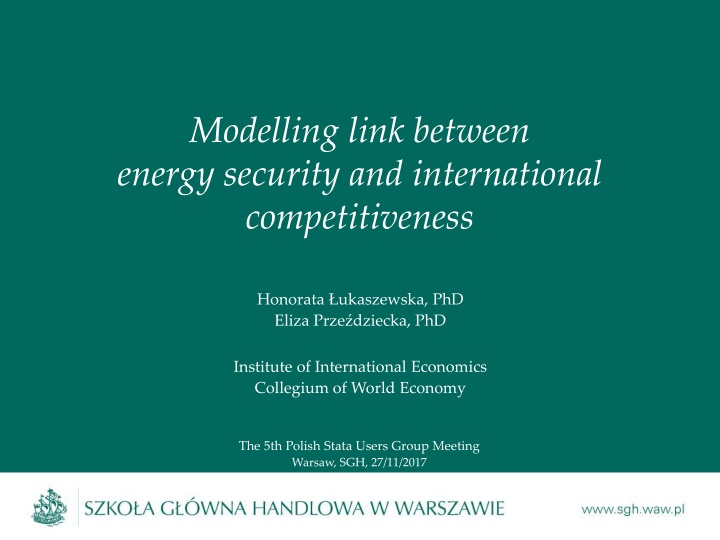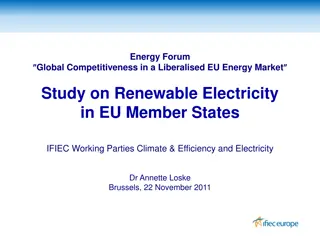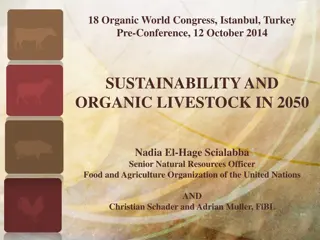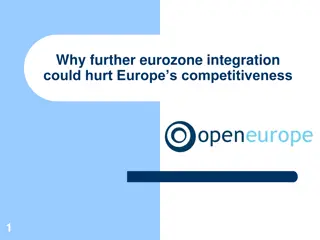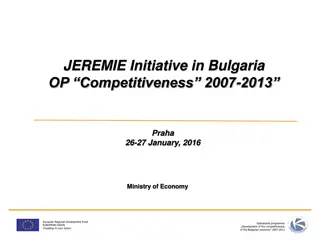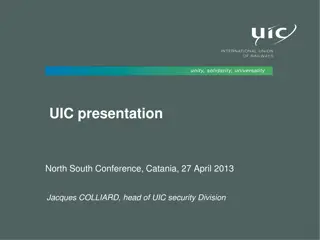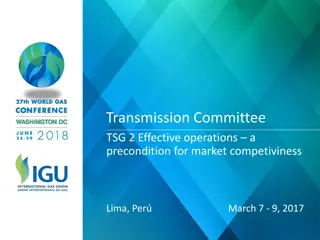Modeling Link Between Energy Security and International Competitiveness
This research presentation by Honorata Łukaszewska, PhD, and Eliza Przedziecka, PhD, at the 5th Polish Stata Users Group Meeting in Warsaw explores the relationship between energy security and international competitiveness. The study delves into the ways in which these factors intersect and influence one another, providing valuable insights for policymakers, economists, and industry stakeholders.
Download Presentation

Please find below an Image/Link to download the presentation.
The content on the website is provided AS IS for your information and personal use only. It may not be sold, licensed, or shared on other websites without obtaining consent from the author.If you encounter any issues during the download, it is possible that the publisher has removed the file from their server.
You are allowed to download the files provided on this website for personal or commercial use, subject to the condition that they are used lawfully. All files are the property of their respective owners.
The content on the website is provided AS IS for your information and personal use only. It may not be sold, licensed, or shared on other websites without obtaining consent from the author.
E N D
Presentation Transcript
Modelling link between energy security and international competitiveness Honorata ukaszewska, PhD Eliza Prze dziecka, PhD Institute of International Economics Collegium of World Economy The 5th Polish Stata Users Group Meeting Warsaw, SGH, 27/11/2017
Introduction Energy security Definition (trilateral) (IEA) Measures
Energy security and competitiveness Energy security and competitivenss Energy security Energy Industrial costs Energy availability Energy self- sufficiency Energy efficiency Lieber (1980); Klein (1988) (more than this) G owacka (1996) Bilan i in. (2017) Tvaronavi ien i in. (2015) German industry competitiveness McKinsey (2009) Energy competitiveness Zachmann, Cipollone (2013)
Research assumptions Energy security Research question Export 1995-2014 (energy consumption, International Index of Energy Security Risk, 2016) Geographical scope Australia, Brazil, Canada, China, Denmark, France, Germany, Indonesia, Italy, Japan, Mexico, Holland, New Zealand, Norway, Poland, Russia, India, Spain, Thailand, Turkey, Ukraine, Great Britain, USA
Conceptual model UNCTAD (2002): Dermand factors: lifting up tariff barriers Supply factors: competitive ability (Bie kowski, 1995) Supply factors Deman d factors 1) Macroeconomic surrounding 2) FDI inflow 3) Institutions 4) Energy security Export Export of goods according to the degree of processing: Intermediate goods Consumption goods Capital goods
Variables Explanatory variables gdppc GDP per capita WB fdigfcf FDI as % od Gross Fixed Capital Formation WB er Nominal effective exchange rate WB Quality of Government Institute (corruption, rule of law) icrg ICRG index importnet_1 Net Importer (0,1) WB AmCham Institute for 21stCentury Energy enr_totimpexp Net energy import/TPES AmCham Institute for 21stCentury Energy enr_consumption Energy consumption per capita (MBtu/person) Ameryka ska Izba Handlowa Institute for 21stCentury Energy enr_expenditure Energy expenditures (MBtu na 1000 USD PKB) oil_price Crude oil prices (USD 2015) BP, 2015 AmCham Institute for 21stCentury Energy enr_intensity Energy intensity (MBtu TPES/1000 USD GDP) enr_co2 CO2per capita BP, 2015
Data characteristics and tests Panel data: 23 countries, 20 years 3 sets: intermediates, consumption, capital goods INTERMEDIATE GOODS test results Fixed/random effect Hausman test: hausman fe re RE Heteroscedasticity Breush-Pagan (xttest0) H0 rejected RE, robust Random effect, Heteroscedasticity: xtivreg2
Data characteristics and tests Panel data: 23 countries, 20 years 3 sets: intermediates, consumption, capital goods CONSUMPTION GOODS test results Fixed/random effect Hausman test: hausman fe re FE Heteroscedasticity Wald (modified): xttest3 confirmed, robust Time-fixed effect testparm i.year time-fixed effect Cross-sectional dependence Friedman: xttest2 Pesaran: xtcsd, pesaran residuals correlated Fixed-effect, Heteroskedasticity, Autocorrelation: xtregar
Data characteristics and tests Panel data: 23 countries, 20 years 3 sets: intermediates, consumption, capital goods CAPITAL GOODS test results Fixed/random effect Hausman test: hausman fe re FE Heteroscedasticity Wald (modified): xttest3 confirmed, robust Time-fixed effect testparm i.year no time-fixed effect Cross-sectional dependence Friedman: xttest2 Pesaran: xtcsd, pesaran residuals correlated Fixed-effect, Heteroskedasticity, Autocorrelation: xtregar
(1) (2) (3) (4) (5) (6) le_intrm 1.971*** (14.50) le_intrm 1.562*** (4.81) le_cons 1.886*** (14.85) le_cons 2.092*** (8.42) le_cap 2.079*** (29.37) le_cap 1.628*** (11.29) lgdppc lfdicfgf -0,00812 (-0.36) -0,00764 (-0.32) 0,0245 (0.87) -0,00235 (-0.08) 0,00918 (0.80) 0,0127 (1.13) 0.828*** (3.34) 0.742* (2.43) 1.209*** (4.79) 0.820* (2.57) 0.608*** (4.75) 0.411** (2.91) ler 0.291*** (3.88) 0.150*** (3.90) loil_price 0,18 (1.45) -0,0819 (-1.14) 0,16 (1.23) 0,0996 (1.74) _Iimportnet_1 0,011 (0.09) 0,000348 (-0.00) -0,0124 (-0.08) -0,0443 (-0.32) 0,0886 (1.41) 0,0482 (0.83) -0.893* (-2.16) -0.623** (-3.28) licrg_qog -0,0317 (-0.08) 0,323 (0.72) -0,441 (-0.92) -0,127 (-0.61) 0.137* (2.09) -1.738** (-2.67) -0,245 (-0.98) 0.997** (3.30) 0,787 (1.36) -0.467** (-3.05) 245 0.123** (3.05) -1.671*** (-4.74) 0.383*** (3.52) 1.191*** (5.35) 0.845** (2.87) -0.223*** (-4.38) 245 lenr_totimpexp 0,00802 (0.09) -1.698* (-2.15) 0.472* (2.02) 1.110* (2.08 0,874 (1.36) 0.844*** (7.87) 245 lenr_consumption lenr_expenditure lenr_intensity lenr_co2 0.296** (2.82) 289 -1.010*** (-18.73) 290 _cons -0,234 (-1.44) 291 N R2 -within -between -overall 0,834 0,0013 0,0422 0,8912 0 0,1115 0,9642 0 0,0345 0,9733 0,2416 0,3202 0,946 0,0001 0,0238 0,979 0,0303 0,107
Conclusions Portion of domestic capital formation undertaken by foreigners has no significance for supply capacity. Institution quality has been identified as an negative impact factor, which is opposite finding to previous studies (Rodrik, et al. 2002). Energy security (energy expenditures) is statistically significant and important for intermediate and capital goods export. Availability and environmental issues are more influential than cost aspects.
Further research Deep analyze of selected group, eg. capital goods Taking into account the delay of energy variables (t-1) Controlling the ICRG variable: grouping countries into groups for quality of institutions
Modelling link between energy security and international competitiveness Honorata ukaszewska: hlukas@sgh.waw.pl Eliza Prze dziecka: eliza.przezdziecka@sgh.waw.pl
